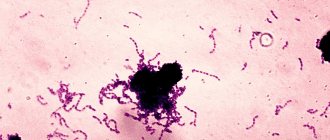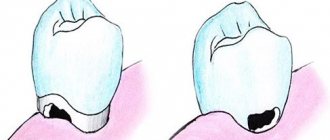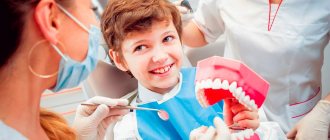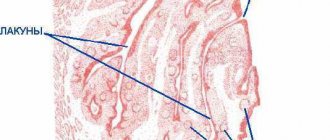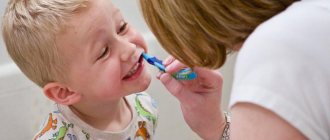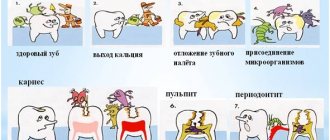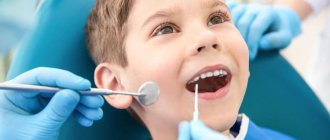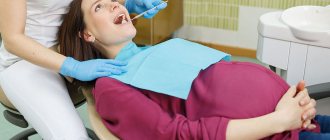Features of superficial caries
Among the main distinctive features of superficial carious damage to teeth in children in comparison with other forms of pathologies, the following should be noted:
- only the enamel layer is affected by pathogenic formations. The dentin remains intact. With timely treatment, the risks of complications are minimal;
- the occurrence of an acute reaction to external stimuli, for example, sour and sweet foods, low and high temperatures;
- if superficial caries is diagnosed in children, treatment can be carried out without tissue preparation;
- Most often, the superficial form occurs in children aged 3-4 years and in adolescents.
Note! Initial caries and superficial caries are two completely different forms. The first appears as a small spot, the second occurs in the absence of treatment. It can be recognized by the presence of small-sized carious cavities.
Diagnosis of multiple caries
If the above-described symptoms appear in a child’s oral cavity, parents should definitely visit a doctor with him. Even if the dark spot is small in appearance, there may be a large carious cavity underneath it.
The specialist will examine the dentition and take measures to confirm or deny the diagnosis. For this, a dental mirror and probe are sufficient.
If necessary, the doctor will order an x-ray or use the transillumination method: using bright light to highlight dark carious cavities inside the teeth. If multiple caries is confirmed in a child, a number of therapeutic measures are prescribed.
Symptoms of the disease
Symptoms of superficial foci of caries are manifested by the following signs:
- visible defect. On the surface of the tooth there is a small cavity with uneven edges. The color of the formation is dark, the bottom is slightly rough;
- pain syndrome. When exposed to cold, hot, sweet and sour foods or drinks, sharp short-term pain occurs;
- hyperesthesia. When inhaling cold air, while brushing your teeth, increased sensitivity occurs.
These are the main symptoms and in each individual case they can manifest themselves differently.
Factors influencing the development of superficial caries in children
The fundamental factors that result in superficial caries in children are:
- eating foods that contain large amounts of carbohydrates;
- non-compliance with hygiene rules: insufficient brushing of teeth, ignoring periodic rinsing with special means, etc.;
- drinking water with a deficiency of fluoride in its composition;
- deficiency of vitamins and mineral elements;
- severe systemic diseases;
- hormonal imbalance;
- ignoring professional hygiene, the need for which arises every 5-6 months.
Any of these factors or several at once are the primary causes of tooth enamel destruction.
Principles of treatment of superficial caries
When superficial caries is detected in children, treatment should be aimed not only at eliminating formations on the tooth enamel, but also at preventing the re-development of the pathology. To prevent complications, comprehensive and immediate therapy is necessary.
When talking about treatment, it should be understood that it is just beginning in the dentist’s office, and it will also need to be continued at home using special means and traditional medicine recipes.
Features of treatment in the pediatric dentist's office
If baby teeth are damaged by caries, then it is quite possible to treat them conservatively without the use of drills, which almost every child is afraid of. Modern dentistry offers more gentle and comfortable methods:
- Children under 3 years of age undergo silvering or deep fluoridation of their teeth. If the enamel has already been damaged by caries, it is cleaned of plaque and treated with a laser. If necessary, cracks in the chewing and frontal teeth are sealed;
- at the age of 3 to 5 years, ozone therapy can be performed to eliminate the first stage of superficial caries, and in case of major complications, treatment is carried out using the method of depophoresis. Its essence lies in the introduction directly into the root canals of a special composition with calcium and copper;
- Children from 5 to 9 years old undergo filling. Glass ionopolymers or colored compomers are used for fillings;
- Children aged 9 to 12 years already have molars and adult technologies can be used to treat them with minimal trauma. But in most cases, therapy of chewing teeth is carried out by sealing fissures.
When superficial caries in children requires complex dental procedures, local anesthesia is mandatory before such procedures are performed. If removal is necessary, such an intervention can be performed under intravenous anesthesia.
Treatment at home
Along with professional treatment of caries by a pediatric dentist, proper oral care at home will also be required to obtain an effective result. For this purpose, special rinsing compositions and toothpastes with anti-caries effects are used.
For children under 4 years of age, dental and oral care products should not contain fluoride. The therapeutic effect is provided by antibacterial active components and calcium ions.
Children over 4 years old are allowed hygiene products containing fluoride, only the concentration of the element must be minimal.
LACALUT kids, PresiDENT Baby, SILPA Putzi, Splat junior are considered good toothpastes for children. You need to brush your teeth with them twice every day. Among the rinses, Drakosha for children, Active Kids, and LACALUT Teens have proven themselves well. When treating caries with such solutions, it is necessary to rinse your mouth after every meal and always before going to bed.
In addition to professional medications, you can also use remedies prepared according to alternative medicine recipes:
- An infusion of chamomile is perfect as a rinse. To do this, pour a glass of boiling water into 1 tbsp. l. dried flowers, leave and cool to room temperature;
- a weakly concentrated solution of sea salt has a positive effect on the condition of teeth. Dissolve 0.5 teaspoons of salt in a glass of water and use for rinsing.
Important! Rinse aids can only be used after the child reaches 1.5-2 years of age, when he can already rinse and spit out liquid on his own, rather than swallow it.
What is the danger of multiple caries?
Many parents believe that it is not necessary to carefully monitor baby teeth: they say, they will fall out anyway. They instill this attitude towards dental health into the child, without paying special attention to oral hygiene. But doctors know: the health of permanent teeth directly depends on the health of baby teeth. If caries is not treated, the infection will spread to their beginnings in the gums.
There are many negative aspects associated with caries:
- discomfort in the teeth when chewing food;
- reaction to cold, hot, sour foods;
- frequent occurrence of colds and infectious diseases.
When teeth are inflamed, the child’s body is more susceptible to other ailments, leading to weakened immunity and stress on vital organs, because everything inside us is interconnected. Therefore, parents of young children should be especially careful about the health of their baby teeth.
Possible complications
Some parents are in no hurry to visit a pediatric dentist because they consider it useless to treat baby teeth. This approach is explained by the fact that permanent ones will grow instead of them anyway.
Although the carious process itself does not transfer from baby teeth to permanent ones, untreated caries lesions have a detrimental effect on the condition of the latter. If you ignore superficial caries in children , complications may very soon manifest themselves:
- caries progresses rapidly in the absence of adequate therapy. This leads to the development of periodontitis and damage to the molar tooth germ. The inflammatory process significantly slows down the eruption of permanent teeth and complicates their growth;
- premature loss of baby teeth leads to the formation of malocclusion and disrupts the structure of the maxillofacial system;
- If at least one tooth is missing in the dentition, this complicates the process of chewing food. As a result, problems arise with the functioning of the digestive system.
Remember! Even the smallest stain can lead to complete tooth decay. There is no need to risk your child's health. It is much easier to visit the dentist and, if necessary, treat caries.
Is it necessary to treat caries of baby teeth?
Despite the “temporary nature” of children’s teeth, treatment and care for them must be thorough and complete. Chronic inflammation in the oral cavity leads to serious problems.
- A baby tooth affected by caries can decay so deeply that it affects the germ of a permanent tooth. The infection will spread to it, and it will grow up with enamel defects or simply die.
- When a baby tooth is removed, the adjacent tooth moves into its place, causing the permanent tooth to erupt in a different place than intended. As a result, the bite is formed incorrectly, and in the future it has to be corrected with braces.
- Advanced caries reduces immunity and causes ENT diseases and even allergies.
- Painful sensations prevent the baby from biting and chewing food correctly, which causes digestive problems.
- The child will be embarrassed about his bad teeth, which will prevent him from communicating with his peers.
It is necessary to treat caries at any age at the initial stage, and it is better to accustom your child to this in advance.
Prevention of superficial caries in children
To prevent superficial caries in children, its prevention should begin during the period of pregnancy. The mother should properly formulate her diet and consume a sufficient amount of foods containing proteins, vitamin D and calcium.
Prevention for an infant is breastfeeding. Breast milk contains all the vitamins and microelements necessary for the full formation of teeth.
When teeth have already erupted, it is imperative to maintain oral hygiene and, after each feeding of the baby, remove food debris and plaque from the surface of the teeth with a napkin.
It is necessary to limit your child's consumption of sweets. Carbonated drinks and sticky candies are considered especially harmful.
You should visit the pediatric dentist at least twice a year. During the examination, a specialist will be able to promptly identify the development of pathogenic processes and carry out safe treatment. This will preserve not only the teeth, but also the health of the baby’s entire body.
